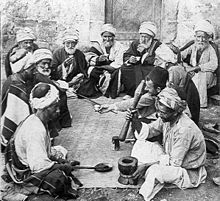Arabic coffee
Arabic coffee ( Arabic قهوة عربيّة, DMG qahwa ʿArabīya ), often just called Gahwa in the Arabian Gulf States , is a coffee drink that, in contrast to mocha or Turkish coffee, is almost clear and golden in color and is usually served unsweetened with dates . The preparation and serving of Arabic coffee is an important sign of hospitality on the Arabian Peninsula , Iraq and Syria . The preparation of the coffee from a number of ingredients takes place in front of the guests in the form of a ceremony. In 2015, this ceremony was added to the Representative List of the Intangible Cultural Heritage of Humanity by UNESCO for the countries of Saudi Arabia , United Arab Emirates , Oman and Qatar .
The UAE Ministry of Culture and Tourism is sponsoring training for the ceremony. Arabic coffee is not to be confused with arabica coffee , a special type of coffee plant .
Preparation and ingredients
The coffee beans are lightly roasted in a pan (tāwa) and with a long- handled spoon (miḥmās) . Then the beans are placed in a container called a Mibrad, in which they can cool down. The beans are pounded in a bronze mortar (minḥāz) while the mortar is struck like a gong to call guests together for coffee.
Three bronze jugs (dilāl) of different sizes are used for cooking, seasoning, filtering and pouring the coffee . The largest is the coffee pot (dallat al-qahwa) , which is used to boil the water . It is also called al-Chamra. The coffee is brewed with the boiling water in a slightly smaller jug called mulaqqima and seasoned with saffron , nutmeg , cardamom , cloves and rose water . The long, beak-like spout of the jug is filled with a small bundle of palm tree fibers and the finished coffee is then filtered into the smallest jug called al-Mizalla.
The finished coffee is now served unsweetened to the guests in small, handleless cups. The cup is only about a quarter full. This should be seen as a sign that the guest is welcome to stay longer and should feel free to ask for the cup to be refilled with an outstretched arm. When he has had enough, he extends the cup and wiggles it slightly up and down, then the host picks it up again.
Individual evidence
- ^ Arabic coffee, a symbol of generosity. In: ich.unesco.org. Retrieved March 9, 2019 .
- ↑ Bait Al Gahwa. In: tcaabudhabi.ae. Retrieved March 9, 2019 .
- ↑ Bait Al Gahwa. In: abudhabiculture.ae. Retrieved March 9, 2019 .
- ↑ Are you drinking that Arabic coffee properly? In: thenational.ae. Retrieved March 9, 2019 .
Web links
- Arabic coffee on the UNESCO Intangible Heritage Section website ( English and French ).
- Arabic Coffee. In: abudhabiculture.ae. December 24, 2017, accessed March 9, 2019 . (PDF, 0.5 MB)


